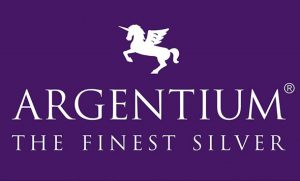Here at Dal Riada Jewellery, we use Argentium 940 Silver for quite a lot of our pieces, so what is Argentium, and why was it created? Argentium is one of a new generation of silver alloys. It was developed specifically to combat the tarnish that occurs as silver oxidises when it comes into contact with air, which is a major drawback for all who love silver. But that’s not the only reason. Argentium also boasts a whole range of other properties besides this, which help to make it an exceedingly clever alloy for those who choose to embrace it.

Argentium logo, Featuring the Winged Unicorn
When was the Argentium alloy created?
Argentium was created in 1991 by Master Silversmith and metallurgist, Peter Johns from Middlesex University. It took 10 years of research to refine and produce, and came about when Metaleurop (who mine and refine metals) contacted Johns regarding two metals they had found, namely indium and germanium, which they were trying to find new uses for. Johns chose to work with germanium and the rest, as the saying goes, is history!
What is sterling silver?
So that’s Argentium, but what is sterling silver made of? Standard sterling silver, as we know it, is made up of 92.5% pure silver with the remaining 7.5% consisting of other metals such as copper, which makes it harder and more suitable for a wide range of varied applications. However, that 7.5% of copper causes fire scale (a dark staining that occurs during prolonged heating) and tarnishing when exposed to air, meaning that silver has to be regularly cleaned to maintain its appearance.
The jewellery industry has tried to overcome this problem by rhodium plating higher quality silver products, but obviously this incurs additional costs and is not always viable for smaller manufacturers. Rhodium resists tarnish and has a lovely bright, white finish which is why it is used on white gold and silver, but it is very expensive.
So what is the difference between Argentium silver and sterling silver?
The main difference between Argentium and sterling silver is their composition. As mentioned, sterling silver is a popular alloy in jewellery making which comprises of a mixture of pure silver and other alloys. Argentium, however, contains a greater amount of pure silver depending on the grade (940 which contains 94% pure silver, or 960 which contains 96% pure silver), with the remainder being made up of other alloys, such as a small amount of germanium.
This unique addition of germanium gives Argentium silver beneficial attributes such as fire stain resistance, improved durability and also a higher melting point, which translates to a higher annealing temperature and flow point. Additionally, Argentium silver can be fused and welded much easier than sterling silver which means it is often favoured by metalsmiths. It is also seven times more tarnish resistant that sterling silver.
Does Argentium silver tarnish?
One of the main selling points of Argenitum silver vs. sterling silver is its resistance to tarnishing. But does Argentium silver tarnish at all?
While it is tarnish resistant, it’s worth making sure that tools you use on the Argentium silver do not have excess residue from other metals on them, as this could cause cross-contamination and leave your work with some tarnish. If possible, keep your polishing buffs for use with Argentium separate to those that you use with other alloys.
In very simple terms, if you replace the copper in silver with germanium, you increase the tarnish resistance significantly. But this subtle difference between Argentium and sterling silver also results in a metal that is stronger, whiter, and easier to fuse and weld. But it also comes with lower temperature hardening capabilities, which is all great news for the silversmith!
Argentium silver vs. sterling silver sales
Clearly it is not a regular occurrence for a ‘new’ metal to be discovered. Argentium has had a huge marketing campaign thrown behind it to educate both suppliers and manufacturers, but also the general public, as to what they are buying into. As you would expect, Argentium is more expensive than standard sterling silver and, because the benefits are largely technical rather than visual, it takes a deeper level of understanding from buying customers to fully appreciate the product – to all intents and purposes, a display of Argentium jewellery will look very similar to a display of rhodium plated silver jewellery. To this end, the makers have developed a very strong brand identity which can be recognised by the winged unicorn logo, which doubles as an additional hallmark that can be stamped onto all pieces of Argentium silver, along with the standard marks.
Hear from the creator himself:
